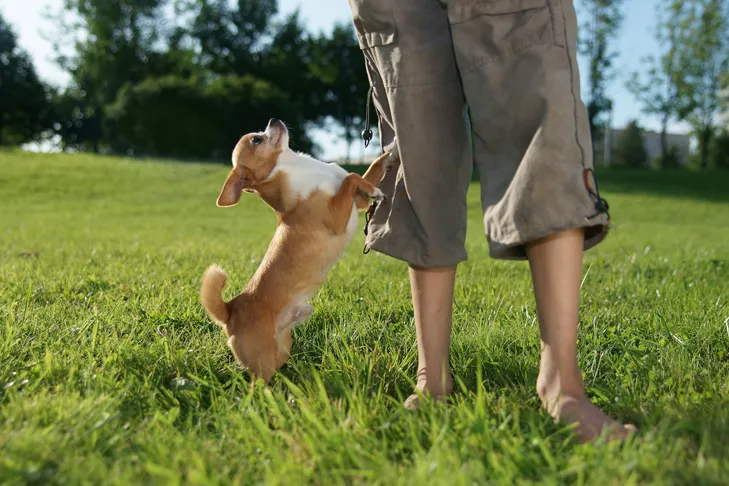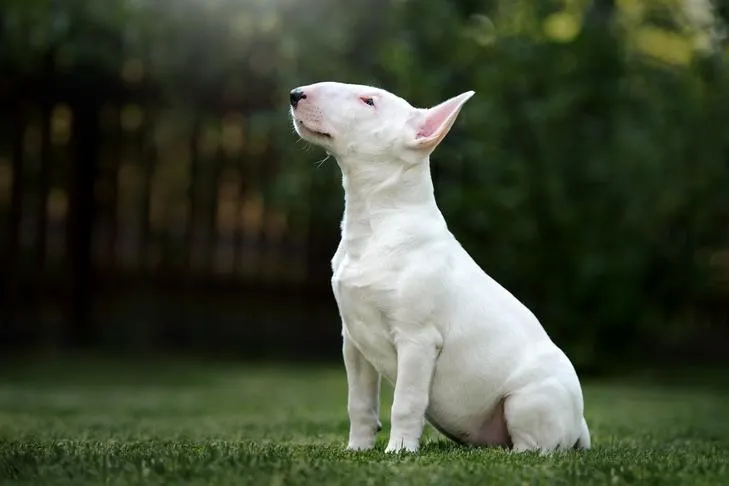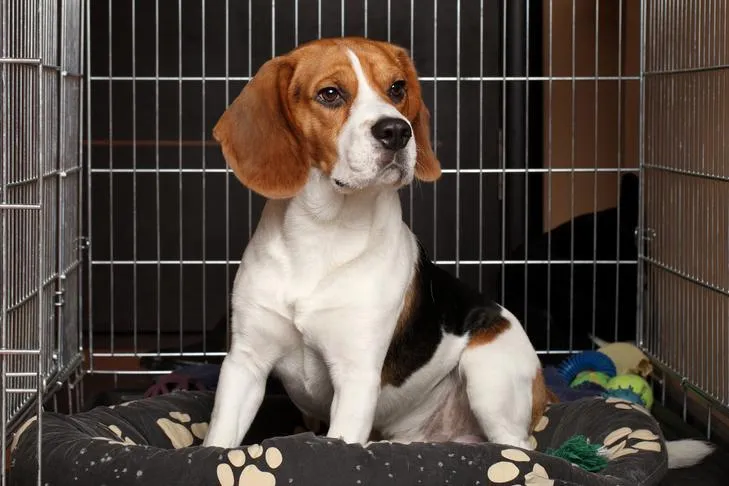Jumping up on people is a common, often innate behavior for puppies and adult dogs alike. For our canine companions, it’s a natural and enthusiastic way to greet, get attention, and interact face-to-face. However, from a human perspective, this can be far from ideal. Muddy paws can soil clothing, and an overly eager jump, especially from a larger puppy or dog, can easily knock over children or seniors, leading to potential injuries. Teaching your puppy appropriate greeting manners is crucial for their safety and for fostering positive interactions with everyone they meet.
The good news is that with consistent training and proper management, you can effectively teach your puppy to greet people politely, keeping all four paws on the floor. This guide will delve into why puppies jump, and then provide clear, actionable steps on how to keep your puppy from jumping on people, ensuring they become a well-mannered companion.
Why Do Puppies Jump on People?
Understanding the root cause of jumping behavior is the first step toward addressing it effectively. Puppies, much like children, learn through reinforcement. If a behavior consistently earns them a desired outcome, they are likely to repeat it.
Natural Canine Behavior
For dogs, jumping is often a natural way to say hello. In a pack, puppies might jump up to reach their mother’s face or other adult dogs as a sign of deference or to solicit attention. When they transfer this behavior to humans, they are simply attempting to interact in a way that feels natural to them.
Seeking Attention and Rewards
The primary reason puppies repeat jumping is that it’s almost always rewarded, even unintentionally. To your puppy, few things are more valuable than your attention. When your puppy jumps, they are guaranteed to get a reaction. This attention can come in many forms:
- Positive attention: Petting, talking to them, enthusiastic greetings.
- Negative attention: Yelling, pushing them away, grabbing their paws.
Even negative reactions are still attention from your puppy’s perspective. For many dogs, being pushed away can even feel like part of a playful wrestling game, further reinforcing the behavior. To successfully stop this behavior, we must remove these perceived rewards.
 Small dog jumping up on a person's leg outside
Small dog jumping up on a person's leg outside
Teaching Your Puppy Alternative Greeting Behaviors
Simply telling your puppy “no” or pushing them away without offering an alternative can be confusing and frustrating for them. Instead, the goal is to teach your puppy what to do instead of jumping. This involves rewarding desirable behaviors. You might aim for all four paws to remain on the floor, or you might prefer your puppy to sit or lie down politely during greetings. Remember, a clear, positive instruction like “sit” for greetings is much easier for a puppy to understand than a prohibition like “don’t jump.”
Training “Four Paws on the Floor”
This method focuses on preempting the jump by rewarding your puppy before they even consider leaving the ground. The idea is to associate keeping all four paws on the floor with positive reinforcement during greetings.
Here’s how to train your puppy to keep four paws on the floor:
- Preparation: Have your puppy on a leash. Ask a friend or family member to act as a greeter.
- Initial approach: As the person approaches your puppy, but before your puppy has a chance to jump, toss several small, high-value treats on the floor right in front of your puppy.
- Reward and retreat: While your puppy is busy eating the treats off the floor, have the person calmly pet and greet them. Before your puppy finishes eating, signal the person to turn and walk away. This prevents over-excitement and gives your puppy a clear end to the interaction.
- Extend the greeting: After several repetitions, once your puppy consistently keeps all four paws down, gradually extend the greeting period. Continue tossing treats on the floor throughout the entire interaction.
- Fade the treats: Once your puppy understands the concept, start allowing them to greet the person before you place the first treat on the ground. Slowly reduce the number of treats you offer, allowing the greeting itself to become the primary reward.
The key to this technique is timing. You need to be quick in anticipating your puppy’s jumping behavior and provide the treats before it can occur. If your puppy does jump, the person should immediately turn and walk away, and you should stop offering treats. This teaches your puppy that jumping yields no reward, while keeping paws on the floor brings attention and goodies.
Training “Sit” for Greetings
Teaching your puppy to sit for greetings is another excellent alternative behavior. This method teaches your puppy that a seated position is what earns them attention and praise.
Follow these steps to teach your puppy to sit for greetings:
- Setup: Tether your puppy’s leash to a sturdy object like a doorknob or heavy piece of furniture. This prevents them from physically jumping.
- Controlled approach: Stand a few feet away and ask your puppy to “sit.” When they do, calmly approach them.
- Reinforce and withdraw: If your puppy stands up as you approach, immediately turn and walk back to your starting point, then ask for the “sit” again. If they remain seated, walk up to them, quietly praise, and gently pet them. As soon as they stand up, turn and walk away.
- Increase excitement: As your puppy masters sitting calmly for your approach, gradually make your approaches more exciting (e.g., a bit more energetic, but still controlled) to simulate real-world greetings.
- Generalize with others: Once your puppy consistently sits for your greetings, repeat the process with friends and family members, ensuring they follow the same rules.
Remember, practice makes perfect. It’s much easier to teach “sit” for greetings if your puppy has already mastered the “sit” command in various environments and with distractions. Incorporate sitting into daily routines, such as before going outside or before meals. This helps your puppy understand that “sit” is a polite way to ask for things, including greetings. How to stop puppies from pulling on leash often involves similar principles of consistency and rewarding desired behavior.
 Bull Terrier puppy sitting in the yard looking up, with a focused expression.
Bull Terrier puppy sitting in the yard looking up, with a focused expression.
Preventing Jumping While Training Your Puppy
While you’re actively teaching your puppy an appropriate greeting behavior, it’s essential to manage their environment to prevent them from practicing jumping. Every time your puppy jumps and gets a reward (even unintended attention), it reinforces the unwanted behavior, making training harder.
Managing Your Environment
There are several effective ways to prevent jumping at home:
- “Go to your place” cue: If your puppy knows a strong “go to your place” cue, send them to their mat or crate when the doorbell rings or when guests arrive.
- Physical barriers: Use dog gates at your entranceway to create a barrier between your puppy and visitors. This allows your puppy to observe calmly without being able to jump.
- Leash management: Keeping your puppy on a leash when guests are present gives you greater control and can help you redirect them if they attempt to jump.
- Distraction techniques: Keep a supply of toys and treats near your front door. When a visitor arrives, you can toss a treat or toy away from the doorway to occupy your puppy while your guest enters. Your visitor can also use these rewards to reinforce appropriate greeting behavior.
Greetings Outside the Home
Preventing jumping can be particularly challenging when you’re out walking your puppy. You can’t expect strangers to know or follow your specific training rules. Until your puppy has consistently mastered appropriate greetings with friends and family in controlled environments, it’s best to avoid having them greet strangers directly.
Instead, if you encounter people on a walk:
- Use a “watch me” cue: Get your puppy’s attention with a “watch me” command.
- Use a squeaky toy: Squeak a toy to divert their attention as people walk past.
- Create distance: Cross the street or move to the side to create more space between your puppy and passersby.
When your puppy is ready to greet people in public, always inform the person about your training process. Ask them to ignore your puppy if they don’t follow the rules, and only engage when all four paws are on the floor. With patience and consistency, your puppy will learn how to greet people politely, whether at your front door or out on the sidewalk. This consistent effort will lead to a more enjoyable experience for both you and your well-mannered puppy.
 Beagle puppy sitting calmly inside an open crate.
Beagle puppy sitting calmly inside an open crate.
Conclusion
Teaching your puppy not to jump on people is a vital part of responsible pet ownership. While jumping is a natural behavior for dogs seeking attention, it can be inconvenient and even dangerous for humans. By understanding why puppies jump and implementing consistent training strategies, you can guide your puppy towards more polite and enjoyable greetings.
Focus on teaching alternative behaviors like “four paws on the floor” or “sit for greetings,” and always reinforce these desired actions with praise and treats. Equally important is managing your puppy’s environment to prevent opportunities for jumping during the training process. With patience, persistence, and positive reinforcement, you will successfully teach your puppy how to greet people politely, ensuring a happier and safer experience for everyone involved.
